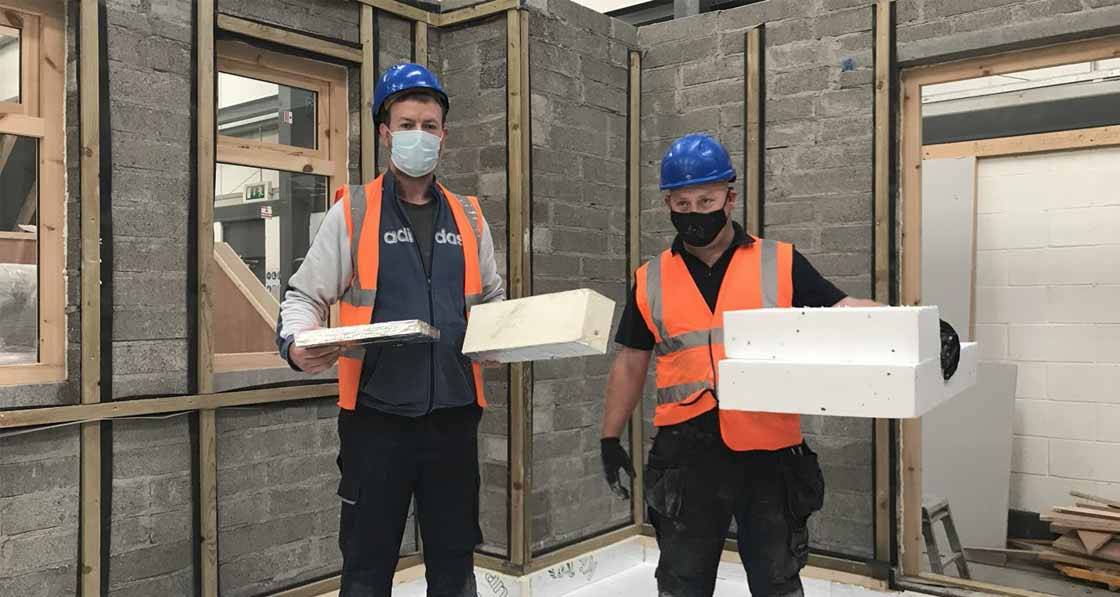
- Insight
- Posted
Runaway train
Following its commitment to retrofit one quarter of dwellings in the country by 2030, the Irish government has now announced the establishment of four new centres of excellence for retrofit training, building on the training approach developed to help the industry meet the NZEB standard for new buildings. Workers from state-owned company Bord na Móna are among the first to undergo training as the company transitions out of peat extraction.
This article was originally published in issue 37 of Passive House Plus magazine. Want immediate access to all back issues and exclusive extra content? Click here to subscribe for as little as €10, or click here to receive the next issue free of charge
As energy efficiency has become the norm in Irish construction, first through one-off homes built by the interested few, and then through regulatory change, the overall quality of the country’s building stock has, naturally, improved. What has remained is the challenge of the existing stock.
Recognising this, the Irish coalition government set a target of 500,000 retrofits to at least a B2 energy rating by 2030 as part of the programme for government it agreed last summer. To deliver that, large numbers of workers will need to be trained to deliver high quality retrofits that genuinely cut energy use while safeguarding the structure of buildings and improving indoor air quality.
Deep retrofit is a complex process that involves understanding the physics of how heat and moisture interact with the structure of buildings. Done poorly, for instance without proper attention to ventilation, it can even exacerbate condensation and dampness. But done well, it can transform the comfort and health of occupants.
In December, Simon Harris, minister for further and higher education, announced the establishment of four new retrofitting centres of excellence in Ireland, as part of a drive to train workers in the skills needed to deliver these retrofits. The centres will be at based at four education and training boards (ETBs) across the country: Limerick & Clare, Sligo, Laois & Offaly, and Cork.
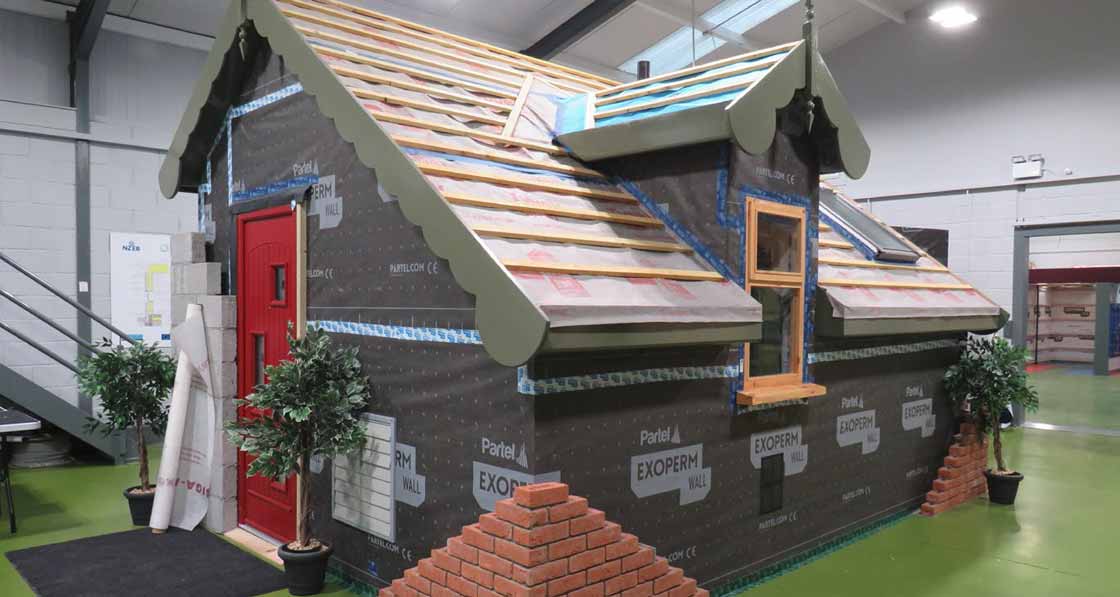
The sample house at WWETB’s NZEB training centre in Enniscorthy, Co Wexford.
Speaking at the time, Harris said: “Today, I am announcing we will establish four centres of excellence – four centres to train 2,000 people in retrofit skills, including near zero energy buildings (NZEB) skills. So, if you are a worker in the construction area and you want to upskill in the area of green skills, then this could be for you.”
As per EU rules, Ireland’s version of the NZEB standard came in time for the 2020 deadline for new buildings, requiring higher standards of energy efficiency in Part L of the building regulations, and a shift towards mechanical ventilation in Part F. The four new centres come in addition to the pioneering work undertaken at the Waterford and Wexford Education and Training Board (WWETB) to establish training courses in NZEB at its Enniscorthy training centre, including a new course in the design, installation and commissioning of ventilation systems to Part F of the building regulations. Expanding this type of ventilation training nationwide will be critical to ensuring that the coming retrofit rollout is done to a high standard.
The good news is that the retraining of workers won’t just create jobs, it will create well-paid, high-skill jobs rooted in building physics, meaning a focus on both careers and climate action, through hands-on training. The truth is, though, that in order to meet its targets, Ireland will need to create an industry almost out of thin air. Harris acknowledged this in December when he said: “The government has set ambitious targets to retrofit 500,000 homes by 2030 but we need to ensure we have the workers to deliver it.”
Unfortunately, and perhaps unsurprisingly given the pandemic and attendant lockdown, 2020 was not a great year for retrofit in Ireland. Sustainable Energy Authority of Ireland (SEAI) figures show the retrofitting programme output fell by 31 per cent in 2020. While 2019 saw 24,700 retrofits, this fell to 16,955 in 2020. Of those, only 196 were deep retrofits; a small number, but at least progress on 2019’s figure of 112 and an indicator, however faint, of movement in the right direction.
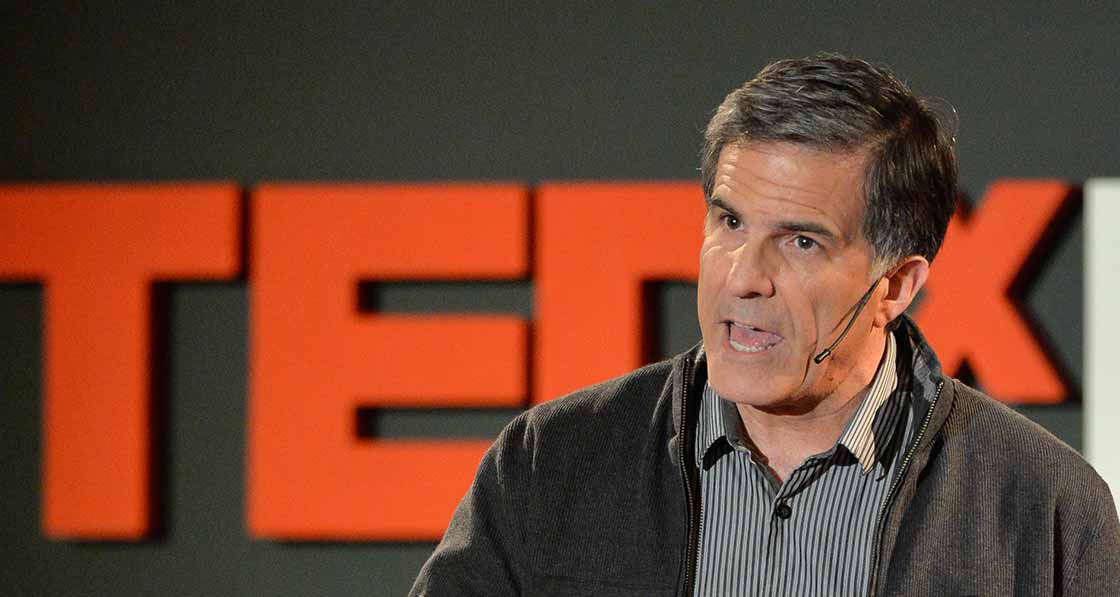
Retrofit enthusiast Scott Foster, head of the sustainable energy division at the United Nations Economic Commission for Europe.
The big picture
WWTEB is not just a national hub for low energy building in Ireland, it is now an international one too. Along with New York, Pittsburgh, Brussels and Vancouver, Wexford is also now a centre of excellence as part of the United Nations Economic Commission for Europe’s high performance buildings initiative (despite its name, UNECE also includes North America).
Scott Foster, who heads the sustainable energy division at UNECE, believes that retrofitting buildings to a high standard also means helping to solve several fundamental problems abroad in society today. “It’s not only climate; it’s jobs, it’s comfort, it’s quality of life, it’s reducing poverty,” he says. “You need a lot of people to do all this work, and you’re not giving money to some centralised organisation. You’re putting money into the hand of the local guy, as well as the local economy.”
The logic behind establishing international centres of excellence like Wexford is to have local centres of training, local examples of best practice, and local leaders who can spread the word about deep retrofit. Pitched correctly, which is to say not as a wagging finger, a mobilisation of retrofitting could have near-universal appeal, Foster says. “This [is the kind of thing that] works under a Biden administration and it works under a Trump administration, and you can’t say that about a lot of initiatives.”
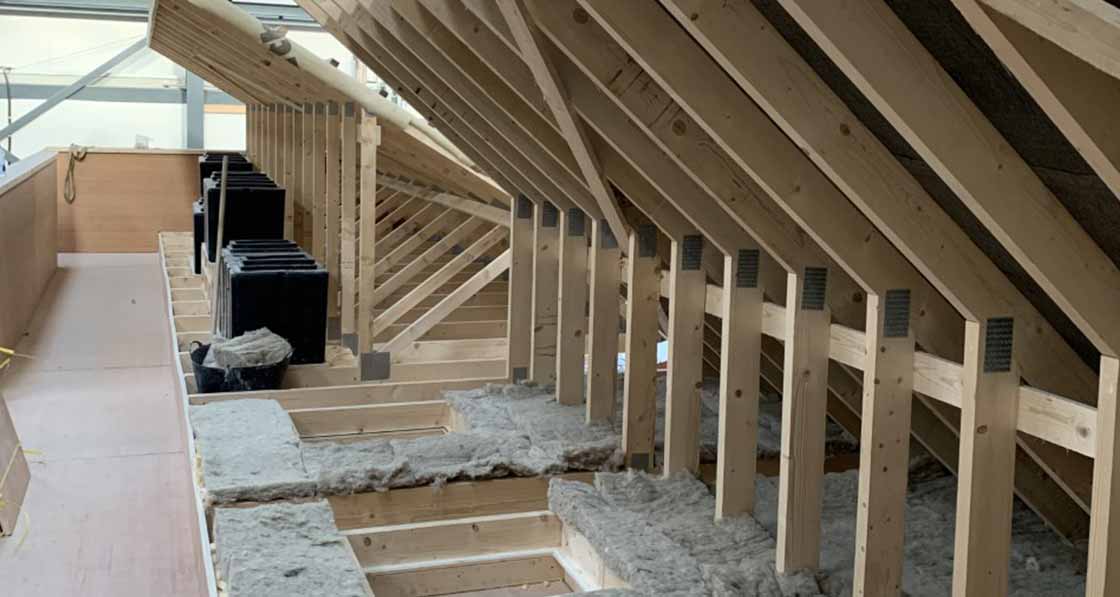
It’s all about reskilling and upskilling all workers affected by decarbonisation.
Leading passive house expert Tomas O’Leary of MosArt Architects and Passive House Academy — and the self-builder of Ireland’s first passive house, built in 2004 — has helped WWETB to develop its NZEB trainings programmes, and the national skills specification it created for NZEB new builds and retrofits.
“New-build is sorted now: the standard is good in terms of insulation, for example. But 40 per cent of carbon emissions globally are from building, and most of that is from existing building stock,” O’Leary says.
O’Leary points to the evidence before our eyes: almost everyone in Ireland knows what it is like to live in a house that is difficult to heat, and many live with mould and high energy bills, even in dwellings built in recent decades. “With the benefit of hindsight we know they weren’t built correctly,” he says.
But O’Leary says if we rush the retrofit process we risk doing a subpar job. Instead, every retrofit should be a carefully executed, full and deep retrofit.
“As we embark on retrofitting we have a choice: do you want to do quality or quantity? My fear is we have to come back in 30 years’ time and do it again. A deep retrofit is disruptive and people are going to be discommoded [so] they won’t want to go through that trauma again.”

Retrofit training rigs at the Mount Lucas national construction training centre.
More than just turf
One major business that has taken notice of the changed environment is Irish semi-state company Bord na Móna, which until recent times developed and extracted large quantities of peat from bogs in the Irish midlands for power stations, domestic fuel and other products.
The company ended peat harvesting operations last year as part of its ‘brown to green’ strategy. In truth, this move has been on the cards for some time.
In July 2019, unions estimated 800 turf jobs would be lost at the company, while in October 2019 then minister for communications, climate action and the environment Richard Bruton told RTÉ there would be a “package of measures that will look at supports for workers”.
If this was to mean more than redundancy payouts, then how it was to be done if Bord na Móna was to become, in the words of its chief executive Tom Donnellan, a “climate solutions company”, was less clear. A year and a half later some clues have begun to emerge. Although it was already working alongside the Department of Climate Action, SEAI and Irish Rural Link (IRL) to inform people about deep retrofitting, the company has now taken a step further by offering training in retrofit to outgoing staff, in association with Laois and Offaly Education and Training Board, which will become one of the new retrofit centres of excellence.
Thomas Fox has spent thirteen years with Bord na Móna, where he currently works as community liaison. Having left his position working in peat, Fox took a deep retrofitting course offered to Bord na Móna workers.
“We knew it was going to happen at some stage, but maybe it’s a bit sooner than we expected. I’ve been the community liaison for a year and a half; I’m out explaining what’s happening on the ground,” he says. A plumber by trade, Fox joined Bord na Móna in the wake of the 2008 economic crash. Now, he says, new opportunities are presenting themselves.
“The climate change agenda has given rise to new career paths. There were 24 of us at the first stage in Mount Lucas [National Construction Training Centre]. There would have been a lot of people with a construction background working on the bogs in Bord na Móna so for someone who has taken redundancy it’s a fantastic opportunity.”
The practical nature of the training served to underscore its utility value for those looking to change careers, he says. “It’s a fantastic course, [trainers] MosArt were fantastic. It was physical and on-site, you can see what you’re doing.”
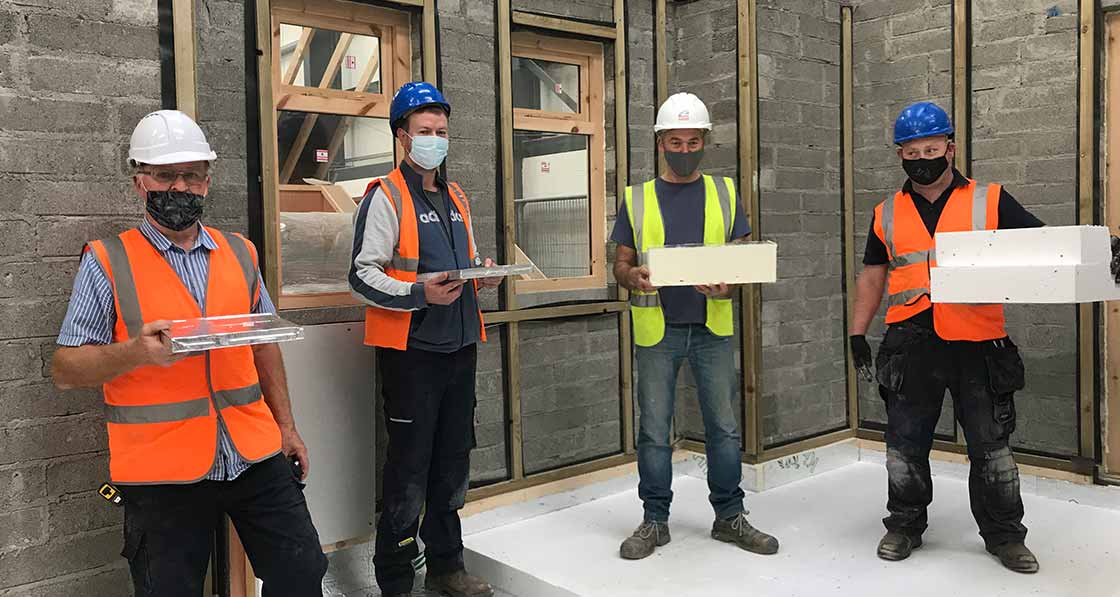
Bord na Mona workers training at Mount Lucas
Ciaran Butler, learning and development specialist at Bord na Móna, says the training is designed to give people choices, and made sense for a changing Bord na Móna.
“It’s just an option for them. It’s all about reskilling and upskilling all workers affected by decarbonisation. Retrofitting aligned with government strategy and we’ve been upskilling a lot of people who are exiting.” Butler signed up for the course himself, and echoes Fox in praising the way the course mixes the theoretical with the practical. “I went through the course myself, I wouldn’t send somebody through a course without assessing it. I feel like I learned a lot through it, in terms of building physics, NZEB, new requirements in the building industry and so on.”
That includes working on typical building styles workers are likely to encounter on the job. “They build mock houses based on Midlands housing stock, so if one of our workers went out they’d know exactly what they were seeing. It really is theory and practice,” he says.
The instructors seem equally pleased. “We’ve been delivering training in China; we’re very active in America; to be standing there with these Bord Na Móna workers is amazing,” says Tomas O’Leary.
“We’ve a bit of education to do… we need to do more to educate people that this is not a low tech, low paid job. On a personal level, delivering these courses is one of the most satisfying things I’ve ever done.”
The NZEB retrofit training programme had its genesis not in the Midlands, but at WWETB, where innovation and development manager Michael O’Brien — himself a physicist — says that necessity was the mother of invention.
“We knew nothing about this stuff until we started attending conferences in 2017; we’re very involved in training apprentices and I could see straight off that there was a need for training and in particular for upskilling in the trades.
“We set about seeking a training programme, as we normally would, only to very quickly realise there was nothing. And in fact there were no learning outcomes or skills specifications.”
Supported by further education agency Solas, WWTEB set about changing this by developing skills specifications and building a training centre in Enniscorthy. It then began delivering courses at the end of November 2018, initially aimed at five trades as well as site supervisors.

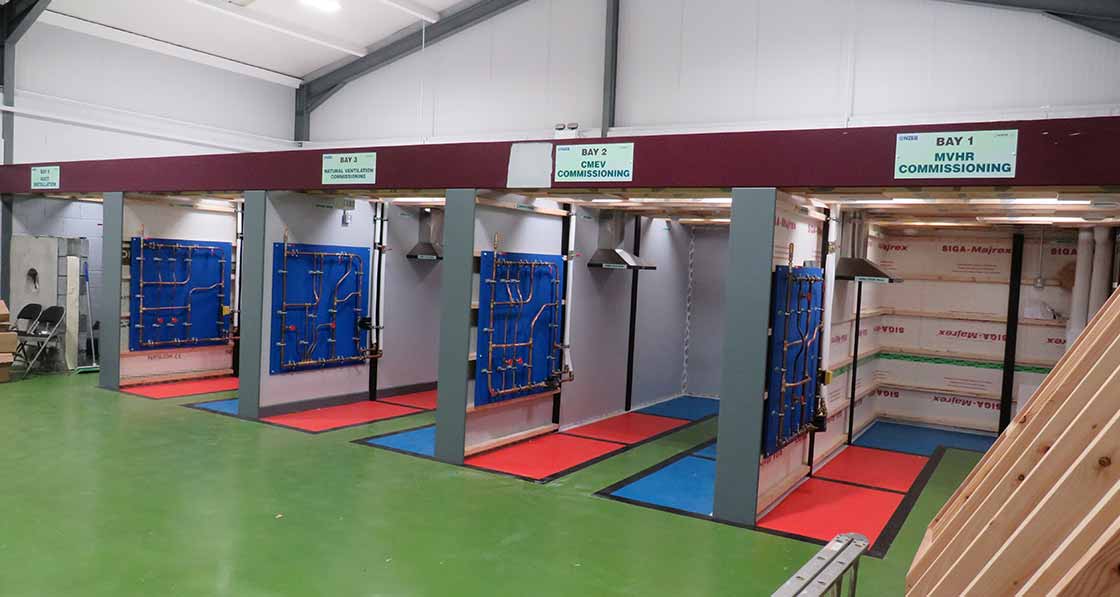
Sample wall types and the ventilation training setup at WWETB
Since then the cohort attending has expanded greatly, in spite of Covid. New courses have been developed, including one that aims to meet a new requirement in the Irish building regulations for competent persons to design, install and commission ventilation systems. Training is offered to anyone involved in building.
O’Brien says that this is because there is more to a building than building. “We felt it was really important that people like auctioneers, people working in sales at building suppliers, and people working on a building site, at any level, understand NZEB and Part L,” he says. “We’ve gone from something that was non-existent to having about ten [training] programmes.”
Beyond individuals moving into the construction sector as retrofit specialists, there is also the possibility of Bord na Móna moving wholesale into retrofit now.
Certainly, this would both align with government strategy and meet Tom Donnellan’s stated green aims for the business. In order for it to happen, though, government policy will have to support it. If it does, local authority housing could start to be transformed, particularly in the Irish Midlands, which has some of Ireland’s highest levels of rural deprivation.
“Yes, we’re looking at the viability of Bord na Móna getting into retrofitting with local government partnerships. There’s been discussion of that at government level but it’s only discussion so far. There’s a lot of work to be done before it’s something that Bord na Móna would look at as a major project,” says Butler. If it does happen, though, it could help to address the biggest issue facing the sector - and homeowners: a lack of scale.
“One of the problems with the retrofit industry [today] is it is a cottage industry,” Tomas O’Leary says, “delivering it at scale will bring the costs down.”




